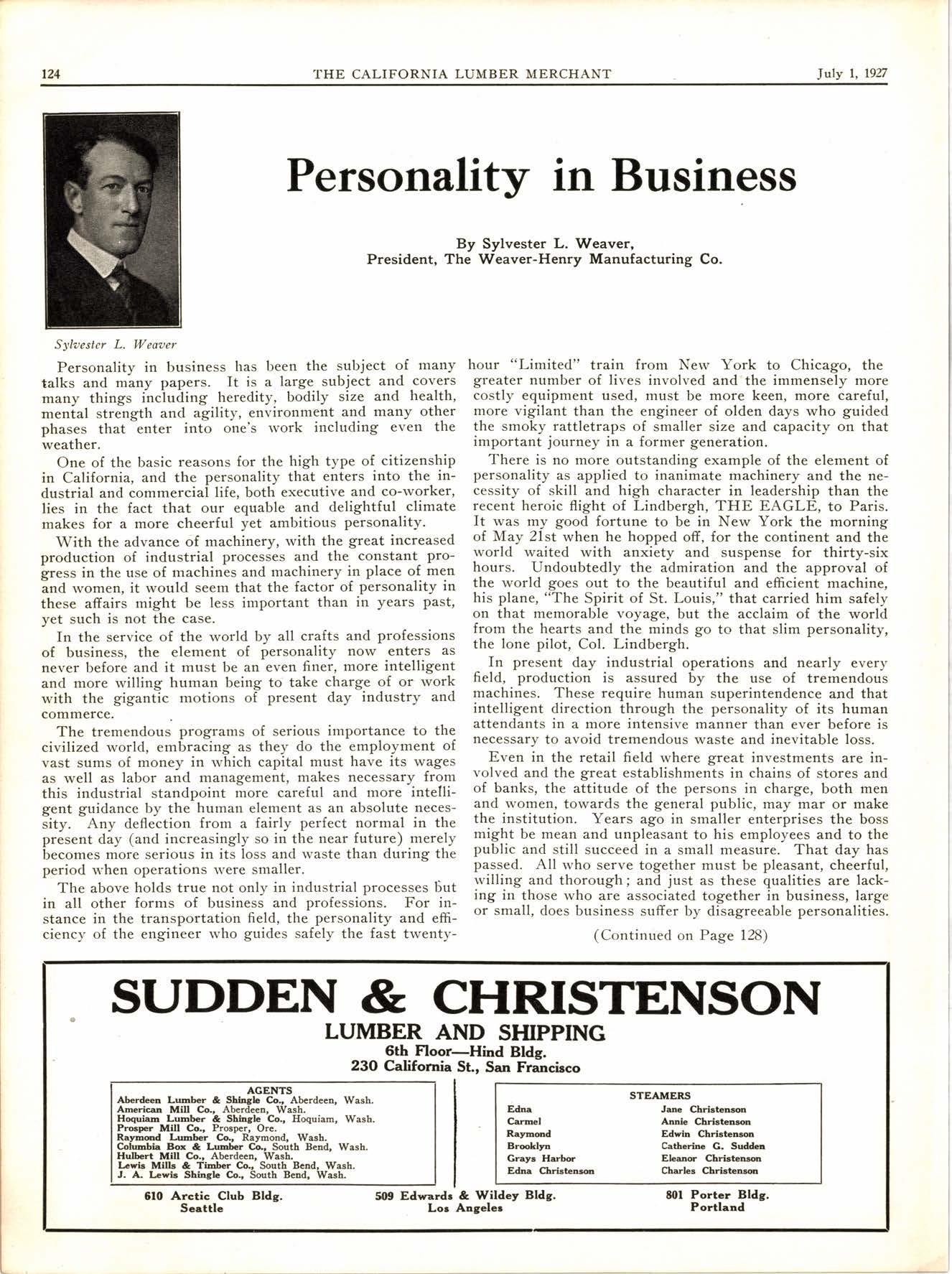
4 minute read
Rough Random on California Market From a Wholesaler's Viewpoint
By Ted Lawrence, Hart-Wood Lumber Co., Los Angeles
Mr. Ted Lazrtrence
A few of us are getting a bit fed up on the criticism that is being heaped on the California Market. Trv and find a market report from a producing section of the Northwest which does not read about as follows: "Export demand improving due to revival of Japanese buying. Middle West Yard Stock-demand fair, price on mixed car orders firm. Atlantic Coast demand increasing-prices firm. California market demoralized due to heavy shipments of transits and large amount unsold lumber at San Pedro. Prices unsatisfacfory and mills not inclined to take cutting accottnt of unattrictive prices offered."
Sure the prices are unattractive. A large portion of the lumber shipped to California could not be marketed tc' advantage elsewhere.
Did you ever notice that it is easier to get good California Oranges in Chicago than it is in Los Angeles ? Th9 lower gradei of -oranges have to be sold somewhere, and the best place is close to home where the transportation cost is not but of balance with the value of the prodttct. The price received by the growers for these low grade oranges is probably unsatisfactory; but they are darn iucky to h,ave a large consuming population at their door to use them.
So are the Lumber Manufacturers of the Northwest fortunate to have the great and growing State of California close enough so that the low cost of water transportation will allow them to market a lot of lumber that used to go into the burner in the old daYs.
About the transit shipment and unsold lumber bug bear(The California Wholesaler is blamed for this,one). Who does this hurt? It is a real service to manufacturer and retailer alike. It allows the manufacturers to cut their logs to the best advantage to meet the requirements of the higher priced markets, knowing all the time that the California whblesalers will have ships calling almost daily to remove from their docks any side cut accumulation. It is hard to find a mill now with more than a rveek's cut of lumber on their dock and it is harder to find more than a day's loading of California stock at any one mill. The California wholesaler takes this stock as fast as it accumulates and pays cash right now for it (and maybe you think some of those mills don't need it.)
This picking up of random stock as fast as it accumulates naturally brings about transit shipments. Lots of this stock isn't tallied until it's ready to load. Try to get an order from some of our retailers for a few thousand feet of 1x3 to l2xl2 clear, and one, two and three common fir or hemlock. They will tell you "come back my boy when the stock is loaded and you have the manifests and I'll see if there are anv items, I- can use".
tfie wholesaler performs a real service by taking this stock and then marke.ting each item to the best advantage.
Manufacturer, Wholesaler and Retailer alike all cry about unsold lumber at San Pedro. The retailer particularly is all wet on this point for several reasons:
Land for good lumber yard sites in a large City becomes more and more valuable as the population increases. To operate economically a yard must keep its fixed investment down and turn its stock quickly. Having stocks of lumber on hand at San Pedro allows the Retailer to opeiate on less ground. It allows him to carry less stock, get quicker deliveries. It allows him to look at stock before he buys to assure himself he is getting stock that will suit his trade. fn general the practice of carrying unsold stock at San Pedro has reduced the fixed investment of the Retailer and his cost of operation- about these tlvo he invented the
If the wholesaler has any kick coming practices he had better talk to himself as system.
The Wholesaler is responsible .for one of the bacl conditions that exists in the California market and that is the over abundance of tonnage. During the last ferv years the United States Emergency Fleet Corporation has been disposing of certain classes of steel vessels to any one who could use them. They have sold vessels costing to build from $500,0@.00 to $1,000,000.00 at ridiculoysly lorv prices. The coastwise wholesalers have been exFrimenting with different types of these vessels for several years. Some of them have worked out satisfactorily and others have not, but in the meantime there has been an oversupply of tonnage operating on the ioast.
This situation will no doubt adjust itself, but in the meantime during this so-called experimental stage the result of the oversupply has caused about a forty per cent reduction in transportation charges from the Northwest to California. This saving brought about by competition has been divided between the manufacturer and retailer. The competition between carriers to get cargo has caused the bidding up of the mill price and the resulting competition to sell the cargo has reduced the selling price.
The methods employed by all three branches of tl,e lumber business on the seasf-1\{anufacturer. Wholesaler and Retailer are far from perfect, but there is no reason rvhy we cannot improve our situation ourselves instead of sitting around praying for snow, fire, flood, earthquake and the merger.
In the meantime why squawk about the California Market ? It is the greatest single consuming market that the Northwest has and takes the largest variety of lumber products and is within one thousand miles of the source of supply with cheap water transportation.
Let's quit knocking the California Market and get a better price by serving it more intelligently.











